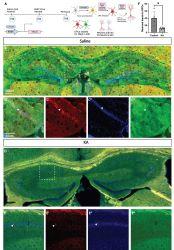
Laura Cocas, Ph.D.
Assistant Professor, Department of Biology, Santa Clara University
Assistant Professor, Department of Neurology, UCSF
Cocas Lab
Following Your Passion and Excitement
As a first-generation college student, I planned to go into journalism. I attended Pitzer College, a small liberal arts college, but I did not know much about careers that I could pursue with a science degree. I thought that if I was not planning to go to medical school, there was no reason to study biology. However, I decided to take a couple of neuroscience classes. I got my first exposure to research at Pitzer, because most of my professors were also researchers. If it was not for them, I would not have started on my journey to becoming a PI.
After taking a few neuroscience courses, I decided to major in both cognitive neuroscience and psychology. Exploring the cellular mechanisms of brain function was more exciting to me than looking at the cellular and molecular functions of an abstract cell. This interest, combined with my experiences conducting research at Pitzer College, is what really got me interested in neuroscience and led me to conducting undergraduate research. I realized that I could have a career that allowed me to ask interesting scientific questions and have the intellectual freedom to explore them. Being in research was a job that did not truly feel like a job, and I did not have to spend all my time in an office—this motivated me to do everything I could to pursue a career in research.
I began my PhD at Georgetown University in their neuroscience program. I loved this program because it allowed me to do different rotations trying various kinds of research. I had conducted human subjects research before, so I decided to do rotations in biochemistry, in neuropharmacology where I worked with primates, and in neurodevelopmental genetics where I worked with mice. I wanted to experience working with various model systems and I realized that I was more excited to ask questions with model systems than I was with human participants.
During graduate school, I was supported by an NINDS F31 and T32 training grants. These allowed me to not only attend conferences and other research events, but I was able to be a part the research-oriented neurobiology course at the Woods Hole Marine Biological Laboratory. I also received a Fulbright Fellowship and went to Switzerland to work with Dr. Peter Scheiffele, where I was able to learn new techniques which I still use today. The funding that I received throughout my training was crucial because I did not have to worry about responsibilities that would take me away from research and academia. It let me stay in graduate school long enough to complete a second first author manuscript which proved to be critical to landing my postdoc.
I did my postdoctoral research at the University of California San Francisco (UCSF) within the Department of Neurology with Dr. Samuel Pleasure. Through my training experiences up to that time, I knew I wanted my future faculty position to be somewhere where I could teach and do research. So, after my time at UCSF, I applied to and accepted an assistant professor position at California State University, Los Angeles where I briefly spent time before moving back to the Bay Area as an assistant professor at Santa Clara University. I was excited to be a part of these institutions because both are primarily undergraduate institutions (PUI) and being at a PUI allows me to teach and do research.
Currently, I have an NINDS R15 grant which supports small scale research grants at institutions that do not receive substantial funding from NIH. This award has funded my lab and has allowed me to train over 25 undergraduate students, of which 75 percent were from backgrounds underrepresented in science. These students have been co-authors on papers and have gone on to medical school, PhD programs, and industry positions. Working with students and knowing that I am training the next generation of neuroscientists is something I find very fulfilling.
Throughout my career, I have found that researchers must develop the ability to work independently and be patient. It’s important to be okay with experiments not working, to be resilient, and to not give up. I find that if someone can troubleshoot and is able to be patient, they can be successful.
Being a great science communicator is another skill that I feel is crucial for all scientists. The outreach I did through the Bridges Program at San Francisco State and the San Francisco City College Biotech Program during graduate school and my postdoc were instrumental in helping me become an effective communicator. This is something that I try to emphasize with my current trainees. I challenge them to communicate science not only to people in their field but also to those in other areas of research. For example, my neurobiology students have projects where they create webpages about their research topic, or they turn papers into short videos to share with larger audiences. I challenge my students to take the details of research and think about it from a big picture lens.
When thinking about the barriers I have faced throughout my journey, the first challenge that comes to mind is the financial struggle of being a trainee in academia. This can create a huge disparity between those that can afford to take various training opportunities and those that can’t. This is why the funding I received throughout my training was so important to helping me stay in academia. I also received an award from the NIH Loan Repayment Program, which reduced my student loan debt from my undergraduate degree. A lot of people who cannot afford to pay their debt do not know about this program, but it is an amazing resource.
Another hurdle I faced was bias about teaching and doing research at a PUI. I was often discouraged from pursuing this path because it was not traditionally seen as a successful career. Luckily, I had great mentors that were supportive of my desire to work at a PUI. Having supportive mentors allowed me to teach undergraduate classes while completing my research, and to pursue a career at a PUI. Now that I am in that mentoring role, I try to use a lot of the approaches that my mentors took with me. My mentors respected who they worked with and trained and cared about their careers. I want to make sure that I am training people to not only be scientists but also encourage them to pursue their own interests.
My advice to other trainees is to try different types of research and training opportunities. Trainees need a breadth of training rather than just only being in the lab. It is important to not be so narrow in your thinking and only focus on small specific questions in research. There are many opportunities out there which allow you to meet different people who could potentially be your mentors in the future. It also helps you find research that excites you and what you are passionate about. A career in research is tough, and it’s important to find something that grounds you from the basic, cellular, and/or genetic mechanisms to something more translational. Knowing why your work matters to human health, mental health, or neurological diseases is a way to do this. If you can ground yourself in your research, know why it is important, and create a community outside of that, it’s an important balance.
Current Research

Oligodendrocytes myelinate neuronal axons to modulate the speed and timing of neuronal activity. This process is dynamic throughout life, but the bulk of synapse formation in neurons and myelination of axons by oligodendrocytes occurs in early postnatal development in mice and humans. Oligodendrocyte Precursor Cells (OPCs) divide throughout adult life, producing new oligodendrocytes that can remyelinate axons after injury and as a mechanism of plasticity. Aberrant myelination is implicated in developmental and mood disorders such as autism spectrum disorder and Schizophrenia as well as depression and bipolar disorder, and it is a key feature of white matter diseases including Multiple Sclerosis and leukodystrophy. Understanding the mechanisms by which oligodendrocytes myelinate axons has the potential to inform treatment for numerous psychiatric and neurological diseases and disorders. Our lab and many others have shown that neuronal activity is instructive for OPC development and myelination. We have also found that pathological neuronal activity from seizures leads to changes in OPC proliferation and differentiation, synaptic connectivity, and myelination. Currently, we are examining Neuroligin synaptic proteins and their role in regulating neuron to OPC synapse formation, OPC development, and myelination.
